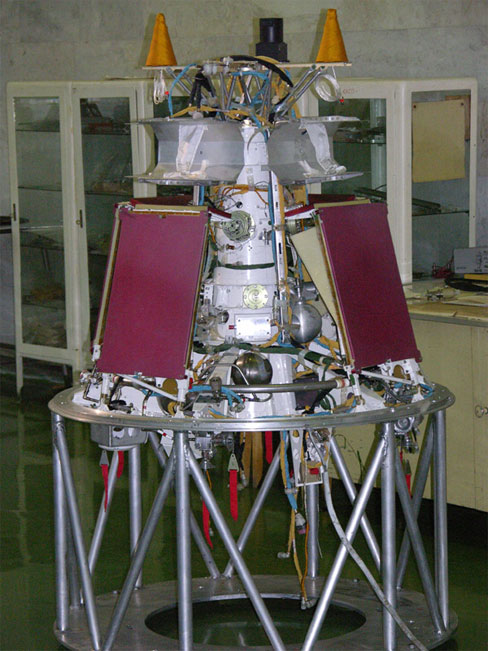Planetary Society’s Cosmos 1 Solar Sail Ready for Flight

A clicking countdown clock has started, leading to a liftoff of the orbital mission of Cosmos 1 -- billed as the world's first solar sail spacecraft.
Launch of the private space mission from a submerged Russian submarine in the Barents Sea is set for March 1, 2005. A Volna rocket, retired from Russia's operational ballistic missile inventory, will boost Cosmos 1 spaceward into a near polar orbit.
The novel project is being undertaken by The Planetary Society, a public space advocacy group headquartered in Pasadena, California and is largely bankrolled by Cosmos Studios, based in Ithaca, New York.
"It's been a long road...four years of development," said Louis Friedman, Executive Director of The Planetary Society and Project Director of Cosmos 1 at a briefing today from the group's facilities. "This is very much a citizen's supported project," he addes.
Tall order
Cosmos 1's mission goal is to perform the first controlled solar sail flight as the spacecraft is propelled by photons from sunlight. "All we want to do is achieve the first solar sail flight...but all we want to do is a tall order," Friedman explained.
The Space Research Institute (IKI) in Moscow oversaw the creation of the flight electronics and mission control software while NPO Lavochkin, one of Russia's largest aerospace companies, built the spacecraft.
Breaking space news, the latest updates on rocket launches, skywatching events and more!
American consultants have provided additional components, including an onboard camera built by Malin Space Science Systems of San Diego, California. Along with a Russian-supplied camera, images of the Earth and the behavior of the sails will be relayed from space.
Global tracking network
The Cosmos 1 launch period will extend from March 1 to April 7, 2005. The actual launch date will be determined by the Russian Navy.
Once the solar sail spacecraft is in Earth orbit, a set of 8 triangular sail blades are to be deployed by inflatable tubes, Friedman said. Several days to perhaps a week of checkout is likely before the blades are in position, he added.
"Then we will begin to fly what we hope is controlled solar sail flight within the second week of the mission...and declare victory," Friedman noted. Cosmos 1 isn't built for a long duration jaunt, but its mission could possibly last weeks to months.
A global network of tracking stations, as well as onboard devices will monitor and measure the spacecraft's status, including the result of sunlight pressure on the Cosmos 1 sails that is expected to alter the craft's orbital energy and velocity.
Depending on viewing conditions, ground observers may well see the solar sail cruise overhead as an object as bright as a full Moon - although it will still be a point of light crossing the background of stars.
Brainstorming other efforts
Friedman told SPACE.com that the complete Cosmos 1 project cost is under $4 million.
The Planetary Society is brainstorming other efforts "to prove that there's a role for commercial ventures like this," Friedman said. Solar sailing to monitor space weather conditions, or perhaps privately-supported missions with the Moon or Mars as targets, might be considered, he noted.
At the status briefing today, the spacecraft was said to be coming together well in order to meet next year's launch date.
"We are sure we will be able to complete all the efforts in a timely manner," said Viktor Kudryashov, Cosmos 1 project manager at NPO Lavochkin via telephone hook-up from Moscow.
Sagan's dream
The announcement today of the Cosmos 1 launch date coincided with the birthday of Carl Sagan, a co-founder of The Planetary Society. He served as President of the group until his death in 1996 and would have been 70 years old today.
Ann Druyan, head of Cosmos Studios, was Sagan's professional collaborator and widow. As Cosmos 1 Program Director, she said that her husband would have been pleased regarding the upcoming solar sail mission.
In particular, using a converted weapon of mass destruction as a means to explore the Universe is a dream of Sagan, "that we would not be just cleaver with our science and technology, but that we would be wise too," Druyan related.
"Happy birthday Carl," Druyan said as she threw the switch that began the Cosmos 1 countdown clock.

Leonard David is an award-winning space journalist who has been reporting on space activities for more than 50 years. Currently writing as Space.com's Space Insider Columnist among his other projects, Leonard has authored numerous books on space exploration, Mars missions and more, with his latest being "Moon Rush: The New Space Race" published in 2019 by National Geographic. He also wrote "Mars: Our Future on the Red Planet" released in 2016 by National Geographic. Leonard has served as a correspondent for SpaceNews, Scientific American and Aerospace America for the AIAA. He has received many awards, including the first Ordway Award for Sustained Excellence in Spaceflight History in 2015 at the AAS Wernher von Braun Memorial Symposium. You can find out Leonard's latest project at his website and on Twitter.
